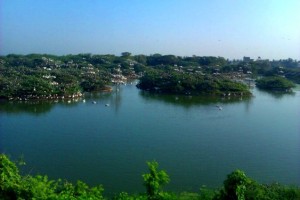National Water Policy
 Water is a significant and life sustaining resource but is also often neglected and is undervalued perhaps because of its free availability in certain parts. In India and also world over, water disputes are not uncommon. In India, we have the Inter Water Disputes Act of 1956 which provides for the establishment of a Tribunal in case of a dispute between states. Read more on water disputes here.
Water is a significant and life sustaining resource but is also often neglected and is undervalued perhaps because of its free availability in certain parts. In India and also world over, water disputes are not uncommon. In India, we have the Inter Water Disputes Act of 1956 which provides for the establishment of a Tribunal in case of a dispute between states. Read more on water disputes here.
India accounts for 15% of the world population and about 4% of the world’s water resources. One of the solutions to solve the country’s water woes is to link the rivers. Read more on it here.
India’s position with regard to availability of water is unique being determined largely by the Monsoon. India receives most of its water from south-west monsoon rains. Water scarcity is a very real threat to Indian industries and the domestic population where large supplies of water are under the control of inter-state riparian systems. Read more on water scarcity here.
Water in India is a state subject and s therefore viewed by each state largely through its own narrow prism of demands and what suits it best. Efforts to streamline and make water a centrally managed asset have met with vehement opposition. This is not surprising as many industries in India are water intensive but this is precisely why water use must be regulated for if neglected, it might affect businesses in the long run. Read more on it here.
The government of India formulated a National Water Mission as part of its commitment to address climate change. Among other things, it envisages Increasing water use efficiency by 20%. Read more on National Water Mission here.
To streamline efforts with regard to water use and its efficient utilisation, a National Water Policy1 was also formulated. Salient features of the National Water Policy are as follows:
| Water, after meeting the pre-emptive needs for safe drinking water and sanitation, achieving food security, supporting poor people dependent on agriculture for their livelihood and high priority allocation for minimum eco-system needs, be treated as economic good so as to promote its conservation and efficient use. | A portion of river flows should be kept aside to meet ecological needs. | Water footprints, and water auditing be carried out for optimum use of this precious resource. Pricing of water should ensure its efficient use and reward conservation. | Equitable access to water for all and its fair pricing should be arrived at through an independent statutory Water Regulatory Authority. |
| All hydrological data, other than classified to be in public domain.
A National Water Informatics Center to be established to collect, collate and process hydrologic data regularly from all over the country, conduct the preliminary processing, and maintain in open and transparent manner on a GIS platform. |
Water resources and services to be managed with community participation. Private sector can to become a service provider in a PPP model to meet service delivery. | Adequate grants to the States to update technology, design practices, planning and management practices. | Preparation of annual water balances and accounts for the site and basin, preparation of hydrologic balances for water systems, and benchmarking and performance evaluation. |
| Conservation of rivers, river corridors, water bodies and infrastructure should be
undertaken in a scientifically planned manner through community participation. |
The over-drawal of groundwater should be minimized by regulating the use of
electricity for its extraction. Recycle and reuse of water, including return flows, should be the general norm. |
Flood forecasting and Frequency based flood inundation maps should be prepared. | Removal of large disparities between stipulations for water
supply in urban areas and in rural areas. Efforts to ensure improved water supply in rural areas with proper sewerage facilities. |
Efficient use of water resources is the need of the hour and cannot be procrastinated as water scarcity is a very real possibility for India. Per capita availability of water in India has reduced to about 33 percent of the level since 19472.
Pollution of water remains a threat and the policy does recognise but fails to adequately address it. The pollution control boards have remained largely ineffective and other bodies such as the Central Groundwater Board have largely remained in the shadows.
However, some measure of success has taken place and the live water storage capacity of about 253 billion cubic meter (BCM) has been created in the country so far. In a first, the ecological needs of river have also been taken into consideration.
References and further Reading-
1. http://wrmin.nic.in/writereaddata/linkimages/NWP2012Eng6495132651.pdf
2. http://newsclick.in/india/draft-national-water-policy-2012-no-clarity-or-hidden-agenda


